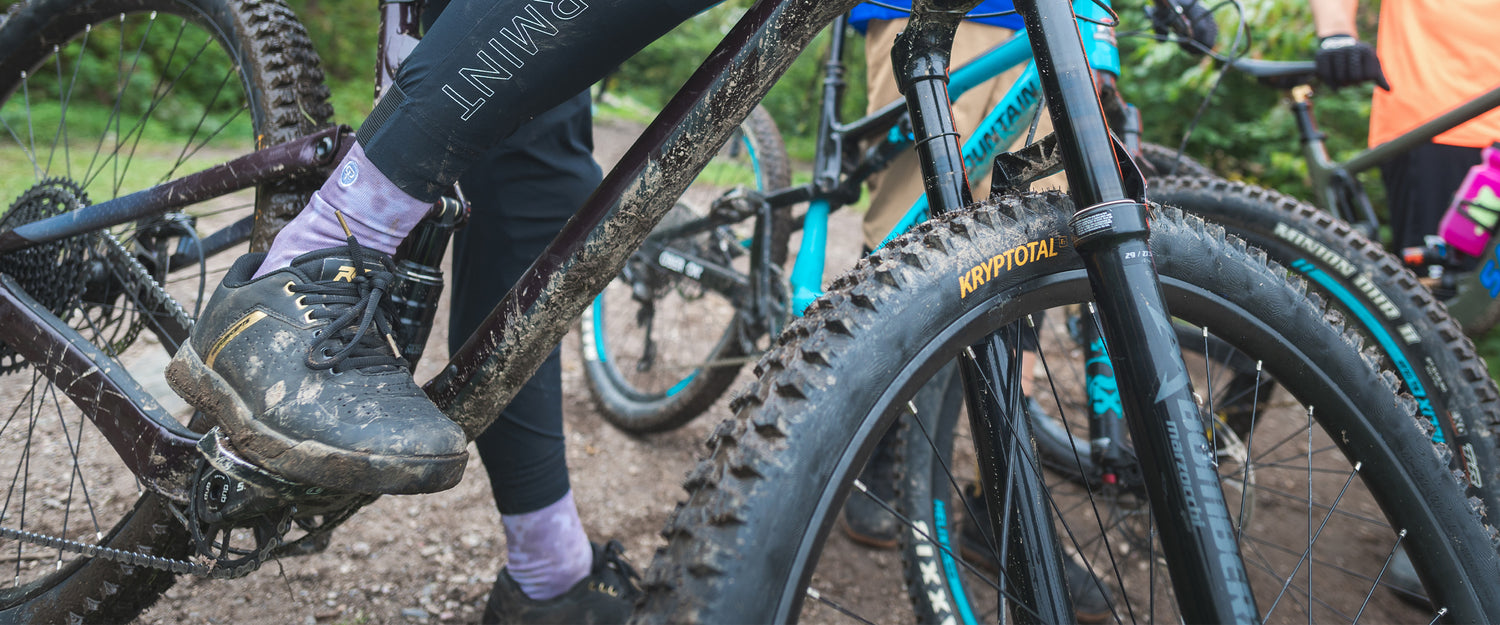1. Platform Pedals (Flat Pedals)
Made of metal or composite materials, mountain bike platform pedals are equipped with pins on their surface that give the shoe a good grip. The surface is wide for proper foot support and stability. On some flat pedal models, the pins are even adjustable using a small tool usually included with the purchase.
Platform pedals are what many beginners will choose as they get acquainted with mountain biking and start progressing. However, many bikers continue riding with platform pedals based on preference and the type of terrain they most often explore. They’re also a great option for hybrid bikes.
Pros
-
More forgiving during crashes because the foot is not attached to the pedals;
-
Ability to put your foot on the ground more quickly, which can make beginners feel more confident;
-
Easy to use, especially during your first few seasons;
-
Less expensive (the price varies widely from $50 to $200).
Cons
-
Require good technique to keep your feet firmly in place on the pedals’ surface
-
Less powerful pedal strokes on climbs

Composite vs. Aluminum Platform Pedals
Both types of pedals are excellent choices. Your budget comes into play here. That said, each has its pros and cons.
Composite Bike Pedals
- Lightweight
- More economical
- Larger
Aluminum Bike Pedals
- More minimalist
- Very durable
- More expensive
Choosing the Size of Platform Pedals
Some bike pedal models allow you to select their size based on your shoe size. You’ll need to choose between small and large. For example, for their Stamp 7 pedals, Crankbrothers suggests small for sizes 5 to 10 and large for sizes 10 to 15. You should consult manufacturers’ size guides.
Bike Shoes for Platform Pedals
If you’re in your first few seasons and don’t own bike shoes, platform pedals are ideal. They can be used with almost any type of sports shoes with a flat, grippy sole.
Platform pedals can also be used with mountain biking shoes with flat soles, such as Crankbrothers Stamp Lace Flat shoes for adults.

2. Clipless Pedals
Clipless pedals are made of metal and allow you to clip the cleats of your mountain bike shoes into your pedals. A piece of metal under the shoe engages with the pedal’s surface through a spring system.
Pros
-
Efficient pedal strokes;
-
Ability to pull during the upstroke;
-
Optimal power;
-
Stability on your pedals when going downhill.
Cons
-
The need to get used to disengaging your foot when crashing;
-
Can be scarier for beginners;
-
More expensive (usually above $100).

Tension and Float
It’s important to differentiate tension and float. Since your bike shoes are clipped in, you need to be able to disengage them to avoid injury during a crash. To that end, you should adjust the tension on the pedals, which is the resistance you’ll need to overcome to free your foot.
Float is your legs’ range of motion when you’re sitting on the bike and clipped into your pedals. The amount of float is measured in degrees. The lower the degree, the less range of motion you have and vice versa. If you’re new to mountain biking, higher float is preferable because you’ll have more mobility.
Bike Shoe Compatibility
Mountain bike clipless pedals are compatible with shoes with two-hole cleats (SPD system). That’s why clipless shoes for mountain biking aren’t compatible with road bike pedals and vice versa.

3. Magnetic Pedals
Magnetic bike pedals are designed as a platform pedal but work like clipless ones. Magnetic pedals have a magnetic system on the pedal and a thin metal plate to insert under your shoe sole. That means that this type of bike pedal is compatible with mountain bike shoes with flat soles.
Pro
-
Provide good uphill traction;
-
Easier to free your foot than with a clipless pedal;
-
No float adjustment needed.

4. Hybrid Pedals
Hybrid pedals are designed to offer both types of pedal surfaces in one pedal. The idea behind its design is to give cyclists a platform side and a clipless side. Hybrid pedals, such as the Crankbrothers Double Shot, are compatible with the SPD system for mountain or gravel bike shoes. The platform surface works with any bike shoe with a flat sole.
Pro
-
Choice of whether you ride clipped in;
-
Can be used on gravel bikes.
Cons
-
Can be hard to find the right side to clip into when you start riding.




